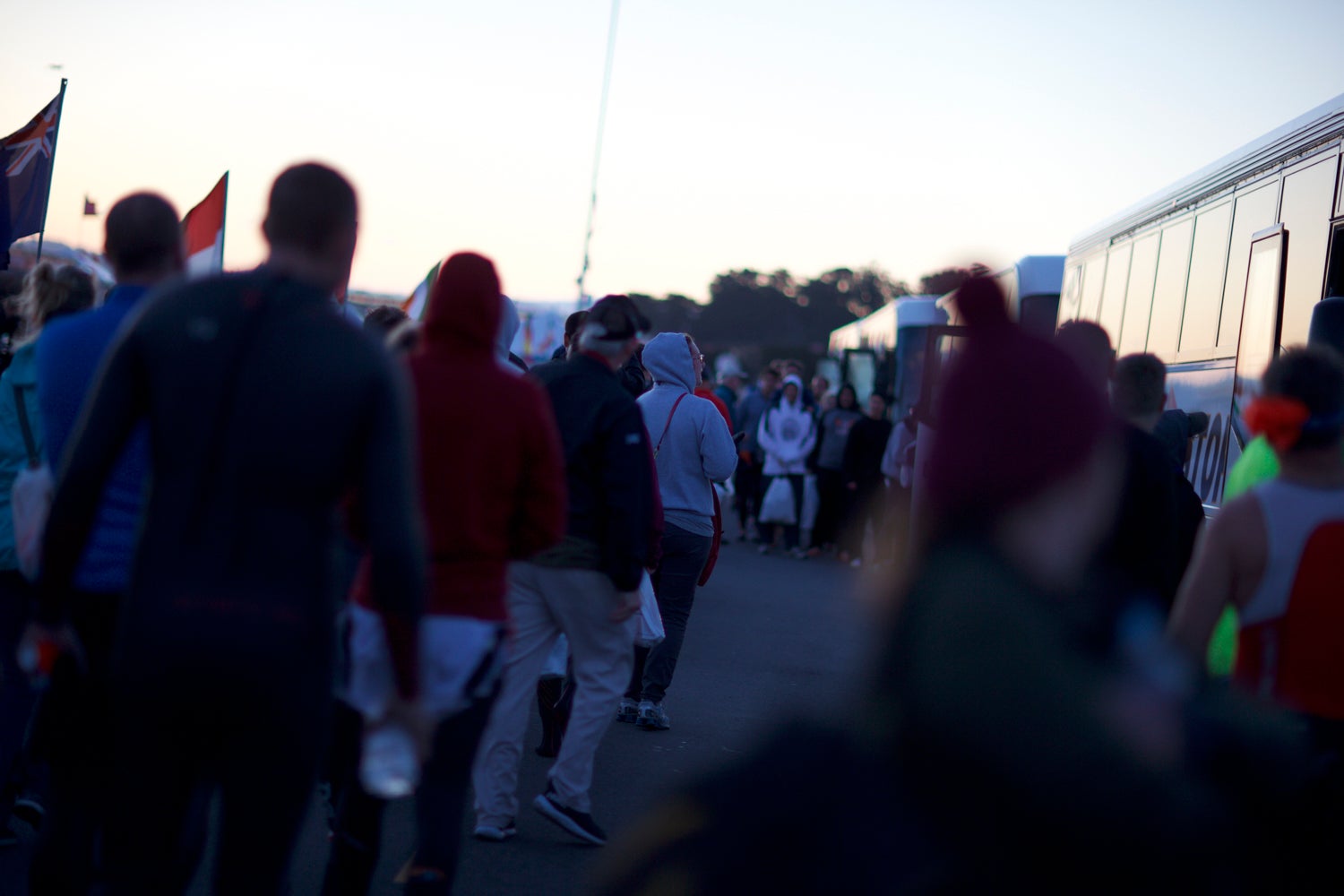Are Swim Cancellations Becoming More Common in Triathlon?

Athletes line up to get back on the busses after the cancelled Escape From Alcatraz swim. Photo: Rocky Arroyo
Why are so many triathlons turning into bike-run affairs?
At 5:44 a.m. on Sunday, June 11, 2017 race director Bill Burke’s greatest fear unfolded into reality as he took a call from the San Francisco Police Department’s Marine Unit. After initially receiving the all-clear to hold the swim at the Escape From Alcatraz Triathlon that morning, the weather had taken a turn. High winds churned the bay into an unrelenting chop, creating conditions too dangerous for small watercraft, including rescue kayaks. And without a water safety team, there was no way Burke could let some 2,000 athletes plunge into the bay.
So, for the first time in the race’s 37-year history, the “escape” itself—where athletes leap off of a ferry adjacent to Alcatraz Island and swim 1.5 miles to Marina Green—had to be cancelled. Burke picked
up a bullhorn, took a deep breath, and informed the athletes to disembark the ferry, strip out of their wetsuits, take a bus back to transition about three miles away, and prepare for an 18-mile bike with an eight-mile run race instead.
This turn of events at Alcatraz was unprecedented, and what Burke—the President/ CEO of Premier Event Management—calls a “worst-case scenario” as a race director. But it’s something triathletes may have to get used to in the near future. While USA Triathlon, the governing body of the sport, does
not keep statistics on the number of cancelled swims at sanctioned events, a simple review of recent races shows a significant bump at major triathlons. “I’ve never seen so many cancelled or altered swims in such a short span of time as I have recently,” says Burke, who has overseen some 900 running and multisport events in his nearly four decades as a race director. “Is it good for the sport? No. But losing athletes during the swim isn’t, either.”
The culprit? Extreme weather. Cold water temperatures (like in Racine, where Lake Michigan recorded a frosty 51 degrees on race morning), dangerous rip tides, fog, flooding, high winds, and large
swells have all forced swim cancellations. Even when swims were called off due to poor water quality, it’s often because of weather. Case in point: The 2016 Nation’s Triathlon in Washington, D.C., when heavy rain in the days leading up to the race dumped gallons of raw sewage and untreated runoff directly into the Potomac River, revealing E. coli levels well above EPA standards.
While safety is the obvious basis for these decisions, that’s not to say a cancelled swim doesn’t come with heaps of frustration—especially from the pros, elite age-groupers and stronger swimmers in the field who can reasonably argue their ability to swim in rough conditions. At Alcatraz, 2016 Olympian Katie Zaferes was among the crowd of athletes already on the ferry when she heard about the race changes. “We wound up having to take an Uber back to [transition] because the bus lines were so long, and it was challenging to restrategize for the bike-run and deciding things from whether to start with my bike shoes on or mounted on bike, whether or not to wear socks, how to warm up and when,” Zaferes says. “Decisions I really never had to make before.”
Though she still fared well by finishing second—duplicating her 2016 result—Zaferes said she would prefer two race-day rulings related to the swim at all triathlons: One for the pros and one for the age-groupers.
Burke has taken this option into consideration, but stresses that it’s just not worth the risk to put any athlete into harm’s way. “This year in Philly, there was debris ripping down the Schuylkill River. Even if you’re the fastest pro out there, you aren’t going to be able to avoid being hit by a log coming at you at full speed,” he says of the modified Philadelphia Escape Tri. “And argue all you want, but every athlete signs a waiver agreeing to the fact that the race director reserves the right to alter the course. Ultimately, I’m the captain of the ship.”
Caryn Maconi, USA Triathlon communications manager, echoes Burke’s stance. “The race director is responsible for assessing the race-day conditions—including air temperature and swim course distance—and decision-making that prioritizes athlete safety and maintains the integrity of the event. The nature of the open-water swim lends itself to unpredictable conditions, and the safety of participants always takes precedence,” she says.
So when it comes to dealing with swim cancellations, what’s a triathlete to do? For starters, have
a back-up race strategy in the event that the swim is called off. Check each event’s athlete’s guide for information about race modifications or reach out to the race director for details on what will happen if a swim is cancelled. And if it does happen? Burke’s best bit of advice is to stay calm and race on.
“Believe me, I understand how frustrating it can be when you train for months and then things don’t go as planned,” Burke says. “But then again, you can’t control the weather.